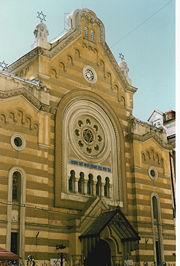
Jewish Museum (Bucharest)
Encyclopedia


Bucharest
Bucharest is the capital municipality, cultural, industrial, and financial centre of Romania. It is the largest city in Romania, located in the southeast of the country, at , and lies on the banks of the Dâmbovița River....
, Romania
Romania
Romania is a country located at the crossroads of Central and Southeastern Europe, on the Lower Danube, within and outside the Carpathian arch, bordering on the Black Sea...
is located in the former Templul Unirea Sfântă (United Holy Temple) synagogue
Synagogue
A synagogue is a Jewish house of prayer. This use of the Greek term synagogue originates in the Septuagint where it sometimes translates the Hebrew word for assembly, kahal...
, which survived both World War II
World War II
World War II, or the Second World War , was a global conflict lasting from 1939 to 1945, involving most of the world's nations—including all of the great powers—eventually forming two opposing military alliances: the Allies and the Axis...
and Nicolae Ceauşescu
Nicolae Ceausescu
Nicolae Ceaușescu was a Romanian Communist politician. He was General Secretary of the Romanian Communist Party from 1965 to 1989, and as such was the country's second and last Communist leader...
unscathed.
The name has several variants, including Museum of the History of the Romanian Jewish Community. In Romanian
Romanian language
Romanian Romanian Romanian (or Daco-Romanian; obsolete spellings Rumanian, Roumanian; self-designation: română, limba română ("the Romanian language") or românește (lit. "in Romanian") is a Romance language spoken by around 24 to 28 million people, primarily in Romania and Moldova...
it is variously called Muzeul de Istorie al Comunitatilor Evreieşti din România, Muzeul de Istorie a Comunitaţii Evreieşti Bucureşti, etc.
The museum gives broad coverage of the history of the Jews in Romania. Displays include an enormous collection of books written, published, illustrated, or translated by Romanian Jews; a serious archive of the history of Romanian Jewry; a collection of paintings of and by Romanian Jews that, while relatively small, consists of works of a calibre worthy of a major art museum (many of the same artists' works hang in the National Museum of Art
National Museum of Art of Romania
The National Museum of Art of Romania is located in the former royal palace in Revolution Square, central Bucharest, Romania, completed in 1937...
); memorabilia from Jewish theaters including the State Jewish Theater
State Jewish Theater (Romania)
Teatrul Evreiesc de Stat in Bucharest, Romania is a theater specializing in Jewish-related plays. Its contemporary repertoire includes plays by Jewish authors, plays on Jewish topics, and plays in Yiddish...
; a medium-sized display devoted to Zionism
Zionism
Zionism is a Jewish political movement that, in its broadest sense, has supported the self-determination of the Jewish people in a sovereign Jewish national homeland. Since the establishment of the State of Israel, the Zionist movement continues primarily to advocate on behalf of the Jewish state...
; a small but pointed display of anti-Semitic
Anti-Semitism
Antisemitism is suspicion of, hatred toward, or discrimination against Jews for reasons connected to their Jewish heritage. According to a 2005 U.S...
posters and tracts; two rooms off to a side, one dealing with the Holocaust
The Holocaust
The Holocaust , also known as the Shoah , was the genocide of approximately six million European Jews and millions of others during World War II, a programme of systematic state-sponsored murder by Nazi...
era from a historical point of view, the other a Holocaust memorial; discussion of both favorable and unfavorable treatment of the Jews by various of Romania's historic rulers; in short, a museum devoted to looking seriously at the history of a particular ethnic group
Ethnic group
An ethnic group is a group of people whose members identify with each other, through a common heritage, often consisting of a common language, a common culture and/or an ideology that stresses common ancestry or endogamy...
within a society. In contrast to its Hungarian
Hungary
Hungary , officially the Republic of Hungary , is a landlocked country in Central Europe. It is situated in the Carpathian Basin and is bordered by Slovakia to the north, Ukraine and Romania to the east, Serbia and Croatia to the south, Slovenia to the southwest and Austria to the west. The...
equivalent in Budapest
Budapest
Budapest is the capital of Hungary. As the largest city of Hungary, it is the country's principal political, cultural, commercial, industrial, and transportation centre. In 2011, Budapest had 1,733,685 inhabitants, down from its 1989 peak of 2,113,645 due to suburbanization. The Budapest Commuter...
, this is not a museum that sees the exodus of the majority of the country's surviving Jews to Israel
Israel
The State of Israel is a parliamentary republic located in the Middle East, along the eastern shore of the Mediterranean Sea...
as a culmination: this museum is focused more on what that means for those who have stayed, what is the continuing contribution of Jews to Romanian culture, what has been, what is, and what will be the role of Jews in Romania.
The Museum also contains a large collection of Jewish ritual objects from Romania, collected by Rabbi Moses Rosen
Moses Rosen
Moses Rosen was Chief Rabbi of RomanianJewry between 1948–1994 and president of the Federation of Jewish Communities of Romania between 1964-1994...
(1912–1994), the late Chief Rabbi of the Romanian Jewry. http://www.hum.huji.ac.il/cja/NL12-romania-ukraine.htm
Security at the museum is relatively high, in no small part because of a December 2000 incident where two anti-Semitic men vandalized the museum and demanded to see the "human soap". http://news.bbc.co.uk/1/hi/world/europe/1091808.stm
External links
- Semi-official English-language page
- Le musée d'histoire des Juifs de la Roumanie, a French-language article about the museum.
- The drawing The Jew With a Book, 1919-1920, by Iosif IserIosif IserIosif Iser was a Romanian painter and graphic artist.Born to a Jewish family, he was initially inspired by Expressionism, creating drawings with thick, unmodulated, lines and steep angles...
, from the museum's collection.

